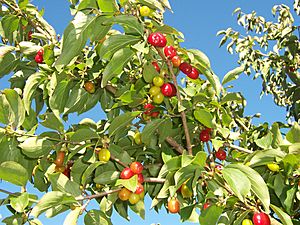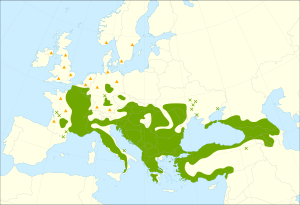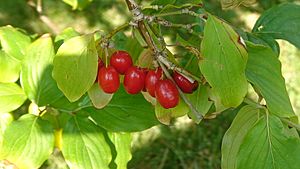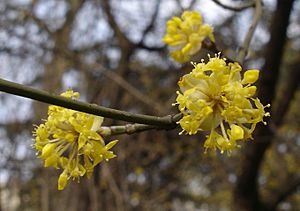Cornelian cherry facts for kids
Quick facts for kids Cornelian cherry |
|
|---|---|
 |
|
| Scientific classification | |
| Genus: |
Cornus
|
| Species: |
mas
|
 |
|
| Distribution map | |
| Synonyms | |
|
Synonymy
Cornus erythrocarpa St.-Lag.
Cornus flava Steud. Cornus homerica Bubani Cornus mascula L. Cornus nudiflora Dumort. Cornus praecox Stokes Cornus vernalis Salisb. Eukrania mascula (L.) Merr. Macrocarpium mas (L.) Nakai |
|
The Cornelian cherry (also known as Cornus mas, European cornel, or Cornelian cherry dogwood) is a type of flowering plant. It belongs to the dogwood family, called Cornaceae. This plant originally comes from Southern Europe and Southwest Asia.
Contents
About the Cornelian Cherry Plant
The Cornelian cherry is a medium to large deciduous shrub or a small tree. It can grow to be about 5 to 12 meters (16 to 39 feet) tall. Its branches are dark brown, and its younger twigs are greenish.
Leaves and Flowers
The leaves grow opposite each other on the stem. They are usually 4 to 10 centimeters (1.5 to 4 inches) long and 2 to 4 centimeters (0.8 to 1.5 inches) wide. Their shape is oval to oblong, with smooth edges.
The flowers are small, about 5 to 10 millimeters (0.2 to 0.4 inches) across. They have four bright yellow petals. These flowers grow in groups of 10 to 25. They appear in late winter, usually between February and March in places like the UK. This happens well before the leaves start to grow.
Fruit
The fruit of the Cornelian cherry is an oblong, red drupe. It is about 2 centimeters (0.8 inches) long and 1.5 centimeters (0.6 inches) wide. Each fruit contains a single seed inside.
Uses of Cornelian Cherry
The Cornelian cherry plant has many different uses, from its tasty fruit to its strong wood.
Edible Fruit
The fruits are red berries that look a bit like coffee berries when they are ripe. They ripen in the middle to late summer. The fruit is edible, meaning you can eat it. However, unripe fruit can taste very sour or astringent (which means it makes your mouth feel dry and puckery).
When ripe, the fruit is a dark ruby red or sometimes bright yellow. It has an acidic flavor, often described as a mix of cranberry and sour cherry. It is mostly used to make jam. In countries like Azerbaijan, it is also used for pickles, added to rice, or made into drinks. In Armenia, people use Cornelian cherry berries to make vodka.
Traditional Medicine
The fruit of Cornus mas has been used in traditional Chinese medicine. It is known as shānzhūyú (山茱萸). In this medicine, it is believed to help keep the body's vital energy, called jing.
Ornamental Flowers
The Cornelian cherry is also grown as an ornamental plant in gardens. People like it for its bright yellow flowers that bloom in late winter. These flowers appear even earlier than those of the popular Forsythia plant. While the flowers of Cornus mas are not as big or bright as Forsythia, the whole plant can create a similar beautiful effect in a landscape.
Strong Wood
The wood of the Cornelian cherry is very dense and heavy. Unlike most other wood, it actually sinks in water! This makes it very valuable for making strong tool handles and parts for machines.
Ancient Greek craftsmen used Cornus mas wood from the seventh century BCE. They made spears, javelins, and bows from it. They thought it was much better than any other wood. The wood was so well known for weapons that its Greek name became a synonym for "spear" in poems during the fourth and third centuries BCE.
In Italy, a traditional stick carried by mounted herdsmen, called butteri, is made from cornel-wood.
Leaves in Medicine
The leaves and fruit of the Cornelian cherry are also used in traditional medicine in parts of Central and Southwest Asia.
Plant Names
The name Cornus mas means "male" cornel. It was given this name to tell it apart from another plant, Cornus sanguinea, which was called the "female" cornel or true dogberry. This distinction was noted by John Gerard in his famous book, Herbal.
Garden History
The Cornelian cherry plant was not originally found in the British Isles. In 1548, William Turner had only heard about it. But by 1551, he knew of one growing at Hampton Court Palace. Later, Gerard mentioned that it could be found in the gardens of people who loved "rare and dainty plants."
People started to really appreciate the early, bright yellow flowers of this plant mostly in the 20th century.
Special Varieties (Cultivars)
Several special varieties, called cultivars, of the Cornelian cherry have won awards. The Royal Horticultural Society’s Award of Garden Merit confirmed these in 2017:
- 'Aurea': This variety has yellow leaves and flowers, and red fruit.
- 'Golden Glory': This one produces many yellow flowers and shiny red berries.
- 'Variegata': This variety has leaves with different colors (variegated) and glossy red fruit.
See also
In Spanish: Cornejo macho para niños



